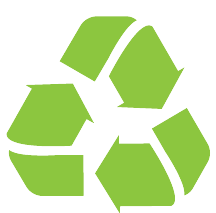Recyclability
Once an item of packaging – whether it is single-use or reusable – reaches the end of its life, we make every effort to recover as many raw materials as possible. To achieve this, the end-of-life phase has to be taken into account as early as at the packaging design stage.

Phasing out non-recyclable packaging by the end of 2025
In 2019, Belgian companies made a voluntary pledge to ensure that all packaging they bring to the market will be recyclable by 2025. This means we are running ahead of the European targets, which do not mandate this until 2030. In recent years, our members have therefore invested extensively in more sustainable packaging, including a focus on switching from multilayer packaging to single materials, and phasing out materials that complicate sorting and recycling processes.
Now those efforts are bearing fruit. In 2023, the volume of non-recyclable packaging on the Belgian market fell below 9,000 tonnes, down from more than 20,000 tonnes in 2019. This development will accelerate in 2024 and 2025, so by the end of 2025 we will see the last non-recyclable packaging disappearing from the shelves in shops.
What about after 2025?
Even after 2025, companies will need to ramp up their efforts further to meet the ambitious targets set out in Europe's new Packaging and Packaging Waste Regulation (PPWR). Recycling will no longer be the holy grail - increasingly the focus is on prevention and reuse. The use of recycled materials in new products and packaging is also increasingly being enshrined in law.
Meanwhile, we are also seeing more stringent recycling targets. It will no longer be enough for the different parts of a composite packaging to be recyclable; the whole item has to be easy to recycle. Efficient and user-friendly collection systems will become more important as a way of ensuring effective recycling, while new recycling technologies and capacities will also be developed.
What is the role of Fost Plus actually?
Over the years we have developed an extensive range of services to help companies make their packaging more sustainable. We also encourage companies through eco-modulation of Green Dot rates. Packaging that is difficult or impossible to recycle is now subject to a much higher rate.
A selection of the services we offer:
- Design4Recycling guidelines
- Best practices
- Packaging diagnoses
- Workshops
- Benchmarks





